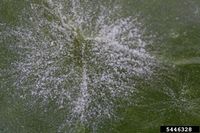Erysiphe betae
| Literature database |
|---|
| 35 articles sorted by: |
| • year (recent ones first) |
| • research topics |
| • countries/regions |
| • host plants |
| • list of antagonists |

Author(s): Oliver T. Neher, University of Idaho
Source: IPM Images
Erysiphe betae (Vanha) Weltzien 1963 - (sugarbeet powdery mildew)
This fungus is widely distributed and causes powdery mildew on sugarbeet. It has been first described from central Europe (as Microsphaera betae) and spread to other regions. For example it was first reported from North America (California) in 1937 and caused severe outbreaks there in the 1970s. Apart from species of the genus Beta, it has been also reported to infect other plants.
Typically, older leaves become infected first with white patches forming on both sides of the leaves. Other parts of the host plant can also become infected and develop chlorosis as well as early senescence. The main source of inoculum are elongated conidia which have a size of around 30–50 µm × 15–20 µm. They disperse by wind and germinate when they land on a leaf surface. The germ tube then penetrates the leaf surface. Sexual reproduction occurs when compatible strains of the fungus are present on the same leaf. This results in the formation of cleistothecia (fruiting bodies) which contain ascospores. The cleistothecia have a diameter of approximately 100 µm.
For a review see Francis (2002).
- Other images of Erysiphe betae (IPM Images - click to enlarge)

